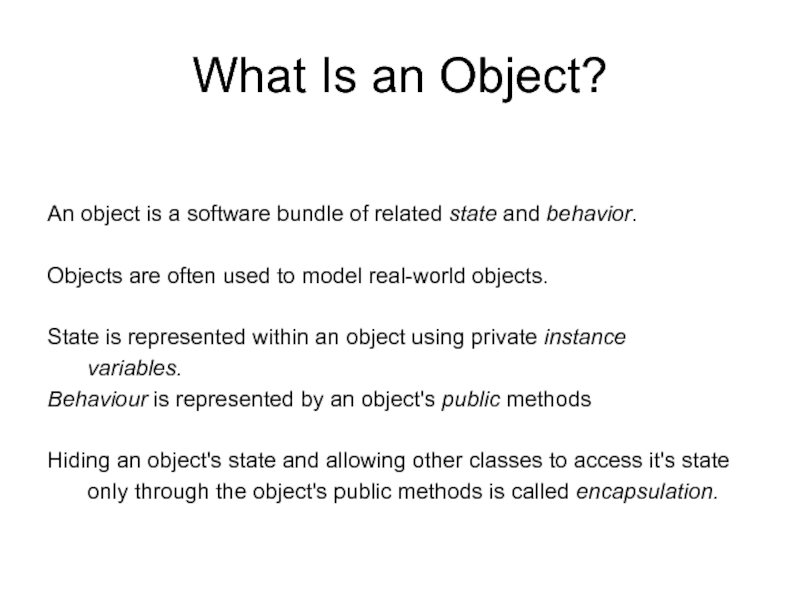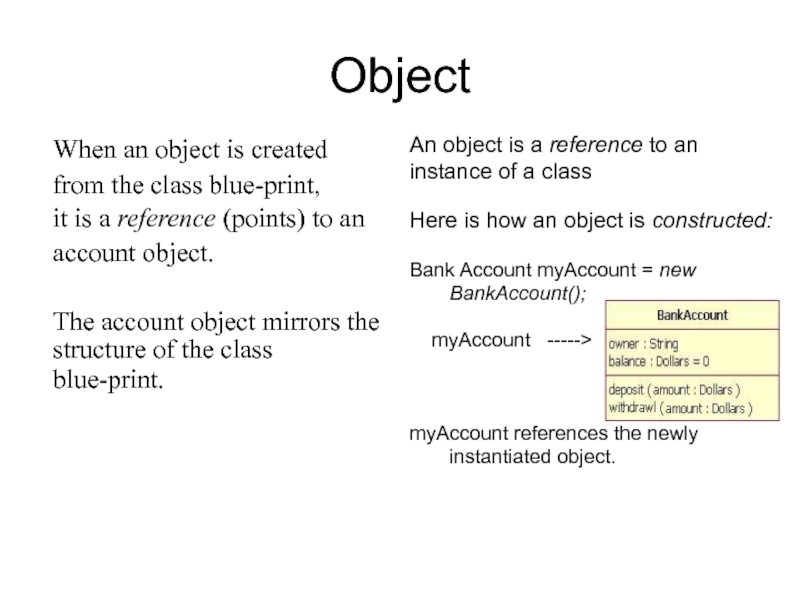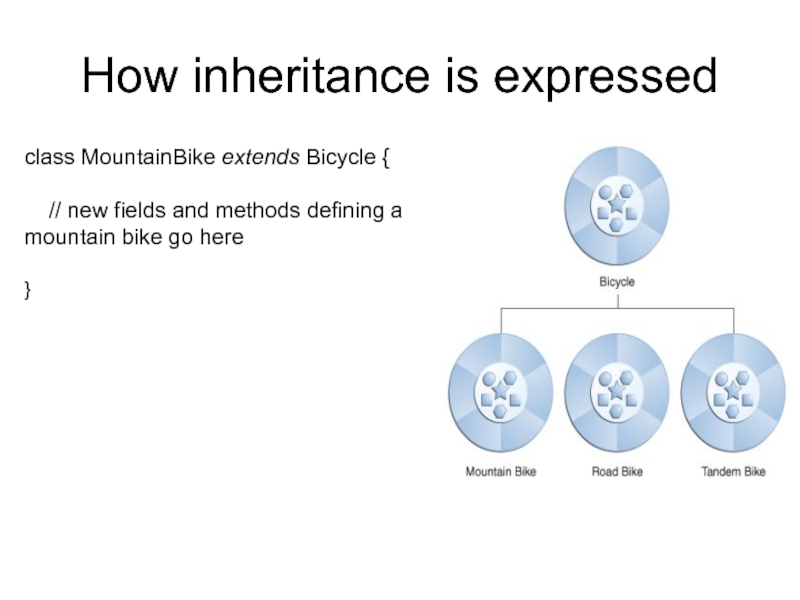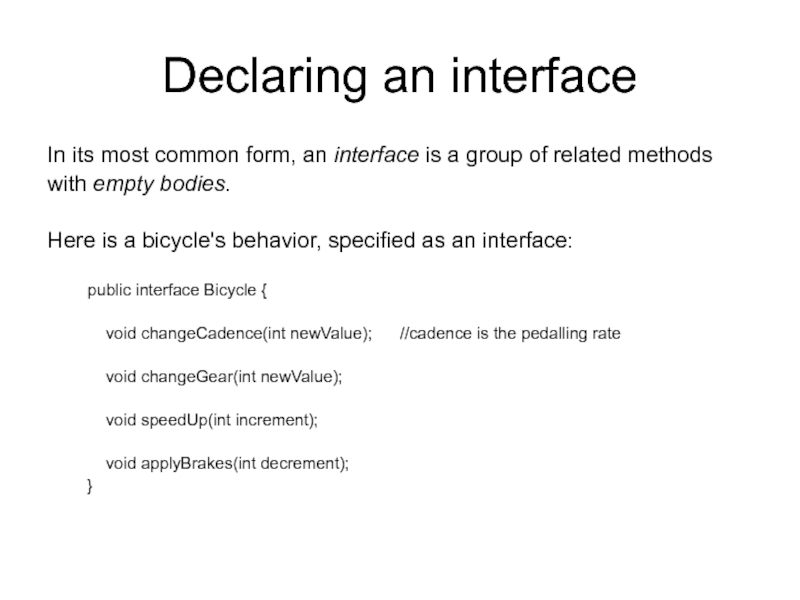Class
Object
Inheritance
Interface
Package
- Главная
- Разное
- Дизайн
- Бизнес и предпринимательство
- Аналитика
- Образование
- Развлечения
- Красота и здоровье
- Финансы
- Государство
- Путешествия
- Спорт
- Недвижимость
- Армия
- Графика
- Культурология
- Еда и кулинария
- Лингвистика
- Английский язык
- Астрономия
- Алгебра
- Биология
- География
- Детские презентации
- Информатика
- История
- Литература
- Маркетинг
- Математика
- Медицина
- Менеджмент
- Музыка
- МХК
- Немецкий язык
- ОБЖ
- Обществознание
- Окружающий мир
- Педагогика
- Русский язык
- Технология
- Физика
- Философия
- Химия
- Шаблоны, картинки для презентаций
- Экология
- Экономика
- Юриспруденция
Fundamental Concepts of OOP презентация
Содержание
- 1. Fundamental Concepts of OOP
- 2. Java Platform from IBM Developer
- 3. Java Platform from IBM Developer Works Java
- 4. What Is a Class? A class is
- 5. Class A class is a blueprint for
- 6. What Is an Object? An
- 7. Object When an object is created
- 8. What is inheritance? Different kinds of objects
- 9. What is Inheritance? Different kinds of objects
- 10. How inheritance is expressed class
- 11. What Is an Interface? An interface is
- 12. Declaring an interface In its most common
- 13. Implementing an Interface We can implement this
- 14. What is a Package? A package is
- 15. The Java API The Java Platform API Specification
Слайд 1Fundamental Concepts of OOP Adapted from a recommended tutorial on OOP using
Слайд 2
Java Platform
from IBM Developer Works Java Tutorials
Java Language
The Java language's programming
is based on the concept of object-oriented programming (OOP);
is a C-language derivative, so its syntax rules look much like C's;
is organized into packages, within which are classes, within which are methods,
variables, constants, and so on.
The Java compiler
When you program for the Java platform, you write JAVA source code that are in .java files and
then compile them. The compiler checks your code against the language's syntax rules, then
writes out bytecodes in .class files. Bytecodes are standard instructions targeted to run on a
Java virtual machine (JVM), rather than a specific Chipset/
The JVM
The JVM reads and interprets .class files and executes the program's instructions on the native hardware platform for which the JVM was written. The JVM is a piece of software for a
particular platform that interprets the bytecodes just as a CPU would interpret
assembly-language instructions. JVMs are available for Linux and Windows, and subsets of the Java are available in JVMs for mobile phones and hobbyist chips.
[The idea of compiling a source language into byte code for a virtual machine came from the
University of San Diego's PASCAL.]
Слайд 3Java Platform
from IBM Developer Works Java Tutorials
Compile and Run a Java
CD myProgram - change to directory where your program is located
javac myProgram.java - compiles to myProgram.class in the same directory
java myProgram - executes the myPogram.class bytecode
The garbage collector
When your Java application creates an object instance at run time, the JVM
automatically allocates memory space for that object from the heap, a pool of
memory set aside for your program to use. The Java garbage collector runs in the
background, keeping track of which objects the application no longer needs and
reclaiming memory from them.
The Java Development Kit, (JDK) and The Java Runtime Environment
When you download a Java Development Kit (JDK), you get — in addition to the
compiler and other tools — a complete class library of prebuilt utilities that help you accomplish just about any task common to application development. (see Resources). The Java Runtime Environment (JRE;) includes the JVM, code libraries, and
components for running Java programs. JAR stands for Java Archive files: it is a
single, zipped file, and many Java programs are stored there. You can freely
redistribute the JRE with your applications.
Слайд 4What Is a Class?
A class is a blueprint or prototype from
which objects are created.
A class models the state and behavior of a
objects of the same type.
Слайд 5Class
A class is a blueprint for a type of entity
Objects are
(constructed, created)
from the class, using the
blueprint
*UML - Unified Modeling Language, a language used in
object-oriented design
Class Diagram (UML)*
Слайд 6What Is an Object?
An object is a software bundle of related
Objects are often used to model real-world objects.
State is represented within an object using private instance
variables.
Behaviour is represented by an object's public methods
Hiding an object's state and allowing other classes to access it's state
only through the object's public methods is called encapsulation.
Слайд 7Object
When an object is created
from the class blue-print,
it is
account object.
The account object mirrors the structure of the class blue-print.
An object is a reference to an
instance of a class
Here is how an object is constructed:
Bank Account myAccount = new
BankAccount();
myAccount ----->
myAccount references the newly
instantiated object.
Слайд 8What is inheritance?
Different kinds of objects often have a certain amount
each other.
Mountain bikes, road bikes, and tandem bikes, for example, all share
the characteristics of bicycles (current speed, current pedal cadence,
current gear).
Yet each also defines additional features that make them different:
tandem bicycles have two seats and two sets of handlebars;
road bikes have drop handlebars;
some mountain bikes have an additional chain ring, giving them a
lower gear ratio.
Слайд 9What is Inheritance?
Different kinds of objects often have a certain amount
Mountain bikes, road bikes, and tandem bikes, for example, all share the characteristics of bicycles (current speed, current pedal cadence, current gear).
Yet each also defines additional features that make them different:
tandem bicycles have two seats and two sets of handlebars;
road bikes have drop handlebars;
some mountain bikes have an additional chain ring, giving them a lower gear ratio.
Object-oriented programming allows classes to inherit commonly used state and behavior from other classes.
In this example, Bicycle becomes the superclass of MountainBike, RoadBike, and
TandemBike.
Each class is allowed to have one direct superclass, and each superclass has the
potential for an unlimited number of subclasses.
Слайд 10How inheritance is expressed
class MountainBike extends Bicycle {
// new
}
Слайд 11What Is an Interface?
An interface is a contract between a class
Objects define their interaction with the outside world
through their public methods - they are the object's
interface with the outside world.
In the real world, the buttons on the front of your television set are the interface between you and the electrical
wiring on the other side of its plastic casing. You press
the "power" button to turn the television on and off. You don't care how this happens as long as it does.
Слайд 12Declaring an interface
In its most common form, an interface is a
with empty bodies.
Here is a bicycle's behavior, specified as an interface:
public interface Bicycle {
void changeCadence(int newValue); //cadence is the pedalling rate
void changeGear(int newValue);
void speedUp(int increment);
void applyBrakes(int decrement);
}
Слайд 13Implementing an Interface
We can implement this interface, using a particular brand
example, an ACMEBicycle:
class ACMEBicycle implements Bicycle {
int cadence = 0;
int speed = 0;
int gear = 1;
public void changeCadence(int newValue) {
cadence = newValue; }
public void changeGear(int newValue) {
gear = newValue; }
public void speedUp(int increment) {
speed = speed + increment; }
public void applyBrakes(int decrement) {
speed = speed - decrement; }
public void printStates() {
System.out.println("cadence:" + cadence + " speed:" + speed + " gear:" + gear); }
}
All methods defined by that interface must appear in a class that
implements the interface before the class will successfully compile.
Implementing an interface allows a class to become more formal about the behavior it
promises to provide.
Interfaces form a contract between the class and the outside world, and this contract is
enforced at build time by the compiler. If your class claims to implement an interface,
all methods defined by that interface must appear in its source code before the class will
successfully compile.
Слайд 14What is a Package?
A package is a name space that organizes
The Java platform provides an enormous
class library (a set of packages) suitable
for use in your own applications.
This library is known as the "Application
Programming Interface", or "API" for short.
Слайд 15The Java API
The Java Platform API Specification
contains the complete listing for all
packages, interfaces, classes, fields, and methods supplied by the Java SE platform.
Bookmark this link!
It is a programmer's single most important
piece of reference documentation for Java.




















